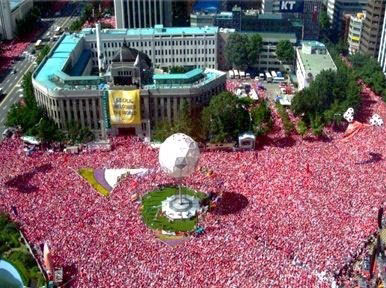Who
are ‘we’, and how are we different from ‘they’?
The identity of ‘minjok’
is one of the most important standards of discriminating ‘we’ from ‘they.’
However, it is very difficult to define and generalize the concept of ‘minjok’
as it has a broad range of meaning. In the case of Korea, the word ‘minjok’ can
include those; who are born in Korea, who maintain Korean nationality, who
spend most of their lifetime in Korea, who speak Korean, who are ethnic
Koreans, or who share Korean history and follow Korean customs. Yet, all of
these have the limitation to fully explain the meaning of minjok. However, it
is certain that people of Korean minjok have had the common features (or
characteristics) shown since our single race had appeared in the past.
Half a million years ago, ‘Dangun’,
now called grandfather, founded Gojoseon which
is the first Korean kingdom. He is said to be the "grandson of
heaven", and we are the “grandson of Dangun.” The word grandson gives us
the feeling of a family that shares the identity. Actually, the awareness about
Dangun’s posterity accompanies a lot of simplification and omission. There are
some races that were involved in Korean race after Dangun’s period, and their
cultures have been formed interacting with foreign cultures. Thus, referring
minjok as a single race or grandson of Dangun is the expression that emphasizes
a strong sense of community that Koreans share each other.
The specific historical fact shows it well. In 1919,
there was the ‘March 1st Movement’, or Samil Movement, which is a civil uprising against Japan's colonial rule.
The 33 nationalists who formed the core of the Samil Movement gathered at
Taehwagwan Restaurant in Seoul, and read the Korean Declaration of Independence.
“We hereby rise up! Conscience is on our side, and
truth marches with us. Men and women, young and old, leave your darkened
corners and partake in the joyful resurrection along with all creation! The spirit of
our many ancestors protects us from within, and the tide of the new world from
without.
To begin is to succeed! Let us march straight into the light!”
People gathered at
Taehwagwan Restaurant not for their own lives, and not just for the reason that
more number of people make them stronger. They had the thoughts of rescuing
minjok from a big suffering. There isn’t any reason for them to devote their
lives to save the nation, but the only motive is the awareness that they are
one big family, minjok. It is considered that this awareness of minjok made
Koreans so easy to be assembled and make a mighty strength. In addition, most
of the declarations of independence emphasize minjok by explaining that those
who fight are the offspring of Dangun.
 Koreans’ tendency of gathering together still remains
nowadays. For example, in 1998 when Korea faced the IMF crisis, people showed a
big sense of community which helped Korea from overcoming the economic crisis
in a short time. They collected contributions of a gold and raised the money by
themselves. Another good example is the ‘2002 World Cup,’ which made all of
Koreans be enthusiastic of cheering the national soccer team. Most of
foreigners just enjoy the World Cup as one kind of sports, but Koreans regard
it as a big festival where everyone raises his or her voice together for the
team. Actually, there’s no reason for them to cheer the players whom they don’t
really know each other. Nobody does it as a result of considering about the
economic gain that winning the World cup could bring to Korea. In contrast,
people just feel that they’re family at the same time they have historically
inborn feature of gathering.
Koreans’ tendency of gathering together still remains
nowadays. For example, in 1998 when Korea faced the IMF crisis, people showed a
big sense of community which helped Korea from overcoming the economic crisis
in a short time. They collected contributions of a gold and raised the money by
themselves. Another good example is the ‘2002 World Cup,’ which made all of
Koreans be enthusiastic of cheering the national soccer team. Most of
foreigners just enjoy the World Cup as one kind of sports, but Koreans regard
it as a big festival where everyone raises his or her voice together for the
team. Actually, there’s no reason for them to cheer the players whom they don’t
really know each other. Nobody does it as a result of considering about the
economic gain that winning the World cup could bring to Korea. In contrast,
people just feel that they’re family at the same time they have historically
inborn feature of gathering.
As the world is becoming ‘a village’ and the boundaries
between the countries are vague, individualism is getting deepened. It is true
that Koreans’ perception through ‘minjok’ is diminishing as time goes by.
However, our strong sense of community acts a great strength that can confront
the world. It would be better if we have tolerance and openness toward other
nations at the same time we raise the self-esteem of minjok.

half a million years of Minjok? one race existing since time immemorial? I wonder how much of the assigned readings you actually engaged; while I find your writing to be a very interesting synopsis of the myth of the Minjok, you were expected to show an engagement with the history of the idea.
답글삭제